Critique of Kwate & Goodman's Article: Racism and Mental Health
VerifiedAdded on 2022/12/29
|6
|1510
|2
Discussion Board Post
AI Summary
This discussion post presents a critical analysis of the research article by Kwate & Goodman (2015) which explores the effects of racism on mental health within Black neighborhoods in New York City. The critique evaluates the research question, which examines the impact of racism on the mental health of African Americans, as a logical extension of the study, and appropriate to the cross-sectional study design. The post examines the sampling methodology, data collection methods, and the appropriateness of the variables used, including experiences of discrimination, daily life practices, psychological suffering, and depression. It also analyzes the inferential questions, hypothesis, and the alignment of these elements with the overall research design and theoretical framework. Furthermore, the critique acknowledges the study's strengths while also highlighting areas for potential improvement, and it references key literature to support its arguments.
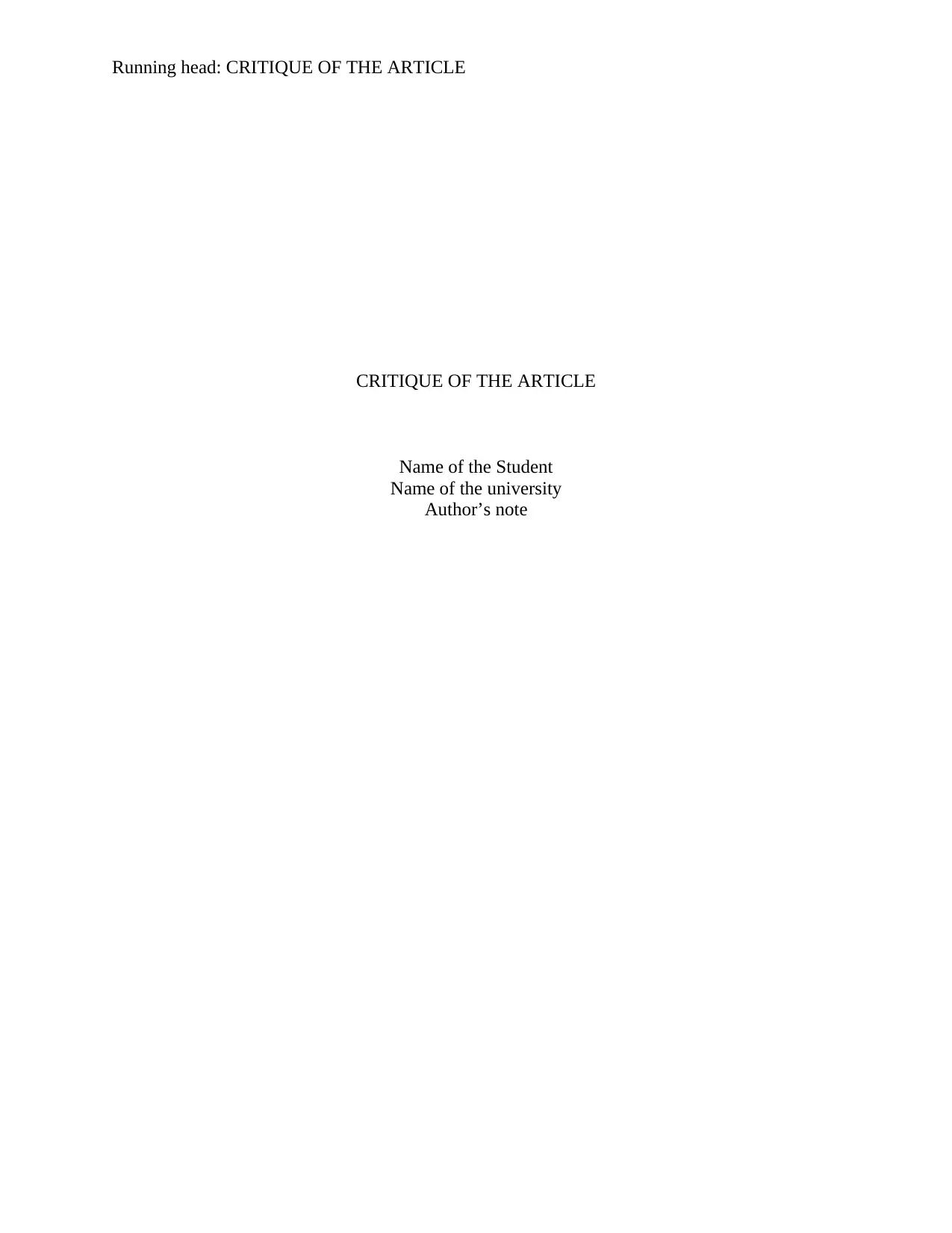
Running head: CRITIQUE OF THE ARTICLE
CRITIQUE OF THE ARTICLE
Name of the Student
Name of the university
Author’s note
CRITIQUE OF THE ARTICLE
Name of the Student
Name of the university
Author’s note
Paraphrase This Document
Need a fresh take? Get an instant paraphrase of this document with our AI Paraphraser
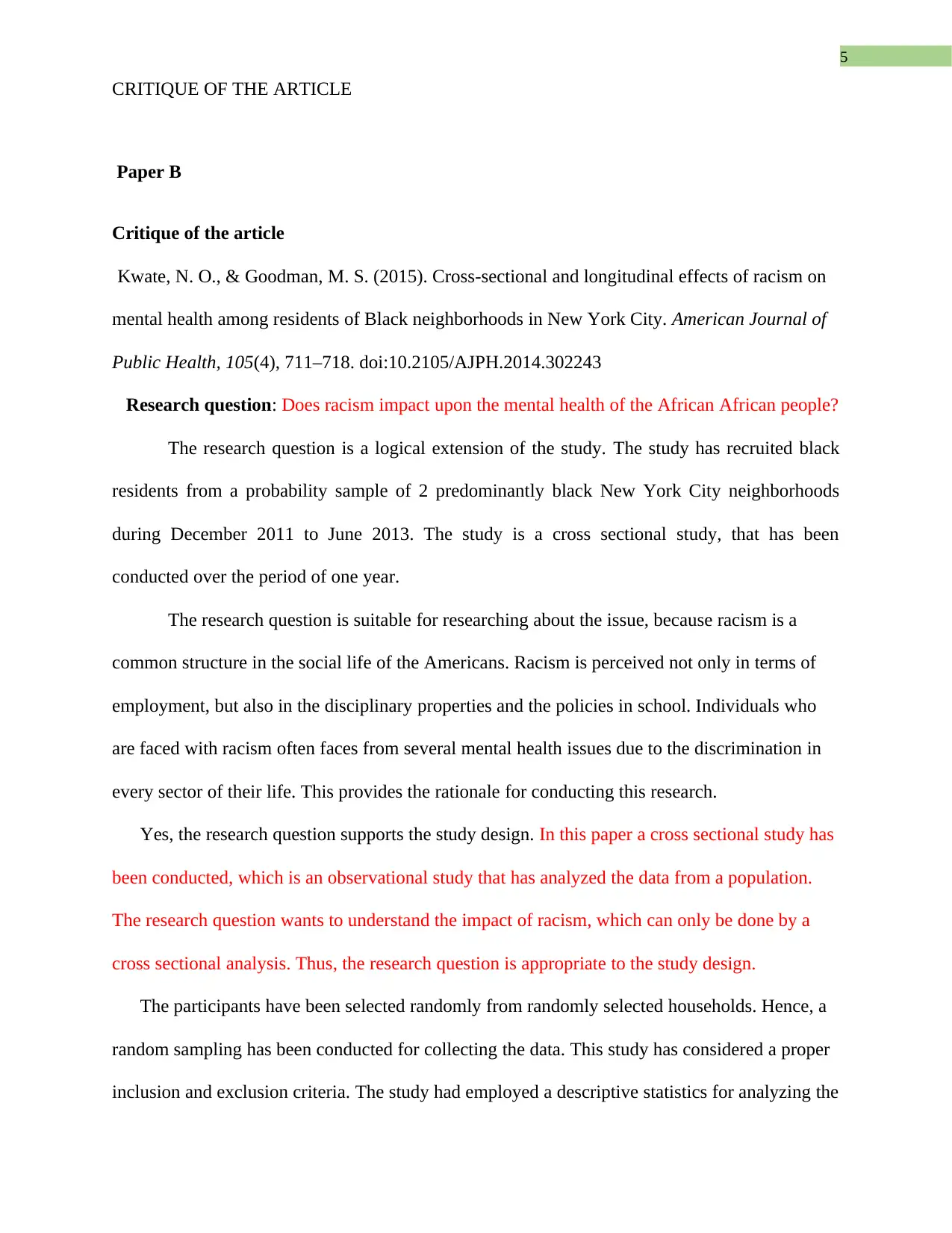
5
CRITIQUE OF THE ARTICLE
CRITIQUE OF THE ARTICLE
Paper B
Critique of the article
Kwate, N. O., & Goodman, M. S. (2015). Cross-sectional and longitudinal effects of racism on
mental health among residents of Black neighborhoods in New York City. American Journal of
Public Health, 105(4), 711–718. doi:10.2105/AJPH.2014.302243
Research question: Does racism impact upon the mental health of the African African people?
The research question is a logical extension of the study. The study has recruited black
residents from a probability sample of 2 predominantly black New York City neighborhoods
during December 2011 to June 2013. The study is a cross sectional study, that has been
conducted over the period of one year.
The research question is suitable for researching about the issue, because racism is a
common structure in the social life of the Americans. Racism is perceived not only in terms of
employment, but also in the disciplinary properties and the policies in school. Individuals who
are faced with racism often faces from several mental health issues due to the discrimination in
every sector of their life. This provides the rationale for conducting this research.
Yes, the research question supports the study design. In this paper a cross sectional study has
been conducted, which is an observational study that has analyzed the data from a population.
The research question wants to understand the impact of racism, which can only be done by a
cross sectional analysis. Thus, the research question is appropriate to the study design.
The participants have been selected randomly from randomly selected households. Hence, a
random sampling has been conducted for collecting the data. This study has considered a proper
inclusion and exclusion criteria. The study had employed a descriptive statistics for analyzing the
CRITIQUE OF THE ARTICLE
CRITIQUE OF THE ARTICLE
Paper B
Critique of the article
Kwate, N. O., & Goodman, M. S. (2015). Cross-sectional and longitudinal effects of racism on
mental health among residents of Black neighborhoods in New York City. American Journal of
Public Health, 105(4), 711–718. doi:10.2105/AJPH.2014.302243
Research question: Does racism impact upon the mental health of the African African people?
The research question is a logical extension of the study. The study has recruited black
residents from a probability sample of 2 predominantly black New York City neighborhoods
during December 2011 to June 2013. The study is a cross sectional study, that has been
conducted over the period of one year.
The research question is suitable for researching about the issue, because racism is a
common structure in the social life of the Americans. Racism is perceived not only in terms of
employment, but also in the disciplinary properties and the policies in school. Individuals who
are faced with racism often faces from several mental health issues due to the discrimination in
every sector of their life. This provides the rationale for conducting this research.
Yes, the research question supports the study design. In this paper a cross sectional study has
been conducted, which is an observational study that has analyzed the data from a population.
The research question wants to understand the impact of racism, which can only be done by a
cross sectional analysis. Thus, the research question is appropriate to the study design.
The participants have been selected randomly from randomly selected households. Hence, a
random sampling has been conducted for collecting the data. This study has considered a proper
inclusion and exclusion criteria. The study had employed a descriptive statistics for analyzing the
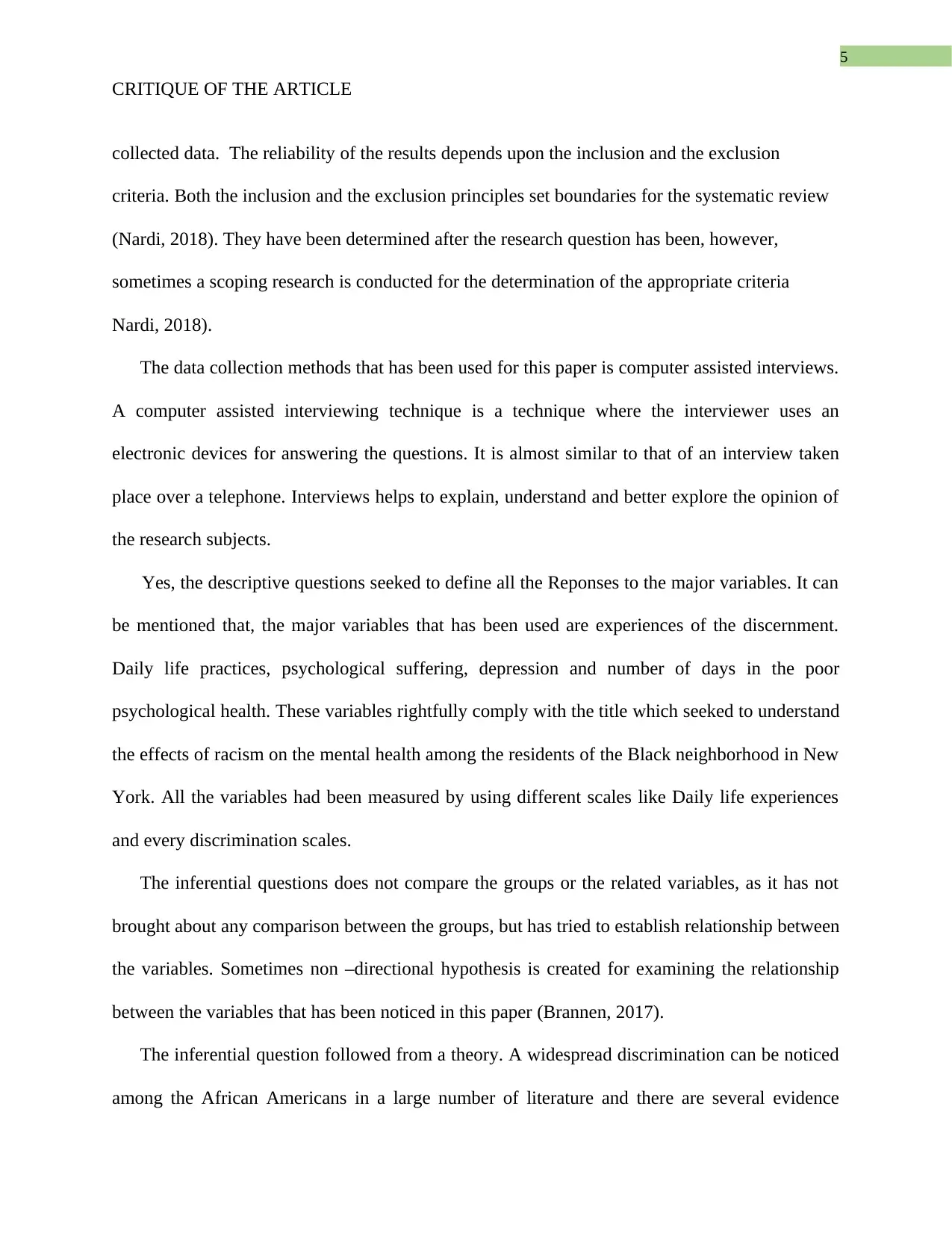
5
CRITIQUE OF THE ARTICLE
CRITIQUE OF THE ARTICLE
collected data. The reliability of the results depends upon the inclusion and the exclusion
criteria. Both the inclusion and the exclusion principles set boundaries for the systematic review
(Nardi, 2018). They have been determined after the research question has been, however,
sometimes a scoping research is conducted for the determination of the appropriate criteria
Nardi, 2018).
The data collection methods that has been used for this paper is computer assisted interviews.
A computer assisted interviewing technique is a technique where the interviewer uses an
electronic devices for answering the questions. It is almost similar to that of an interview taken
place over a telephone. Interviews helps to explain, understand and better explore the opinion of
the research subjects.
Yes, the descriptive questions seeked to define all the Reponses to the major variables. It can
be mentioned that, the major variables that has been used are experiences of the discernment.
Daily life practices, psychological suffering, depression and number of days in the poor
psychological health. These variables rightfully comply with the title which seeked to understand
the effects of racism on the mental health among the residents of the Black neighborhood in New
York. All the variables had been measured by using different scales like Daily life experiences
and every discrimination scales.
The inferential questions does not compare the groups or the related variables, as it has not
brought about any comparison between the groups, but has tried to establish relationship between
the variables. Sometimes non –directional hypothesis is created for examining the relationship
between the variables that has been noticed in this paper (Brannen, 2017).
The inferential question followed from a theory. A widespread discrimination can be noticed
among the African Americans in a large number of literature and there are several evidence
CRITIQUE OF THE ARTICLE
CRITIQUE OF THE ARTICLE
collected data. The reliability of the results depends upon the inclusion and the exclusion
criteria. Both the inclusion and the exclusion principles set boundaries for the systematic review
(Nardi, 2018). They have been determined after the research question has been, however,
sometimes a scoping research is conducted for the determination of the appropriate criteria
Nardi, 2018).
The data collection methods that has been used for this paper is computer assisted interviews.
A computer assisted interviewing technique is a technique where the interviewer uses an
electronic devices for answering the questions. It is almost similar to that of an interview taken
place over a telephone. Interviews helps to explain, understand and better explore the opinion of
the research subjects.
Yes, the descriptive questions seeked to define all the Reponses to the major variables. It can
be mentioned that, the major variables that has been used are experiences of the discernment.
Daily life practices, psychological suffering, depression and number of days in the poor
psychological health. These variables rightfully comply with the title which seeked to understand
the effects of racism on the mental health among the residents of the Black neighborhood in New
York. All the variables had been measured by using different scales like Daily life experiences
and every discrimination scales.
The inferential questions does not compare the groups or the related variables, as it has not
brought about any comparison between the groups, but has tried to establish relationship between
the variables. Sometimes non –directional hypothesis is created for examining the relationship
between the variables that has been noticed in this paper (Brannen, 2017).
The inferential question followed from a theory. A widespread discrimination can be noticed
among the African Americans in a large number of literature and there are several evidence
⊘ This is a preview!⊘
Do you want full access?
Subscribe today to unlock all pages.

Trusted by 1+ million students worldwide
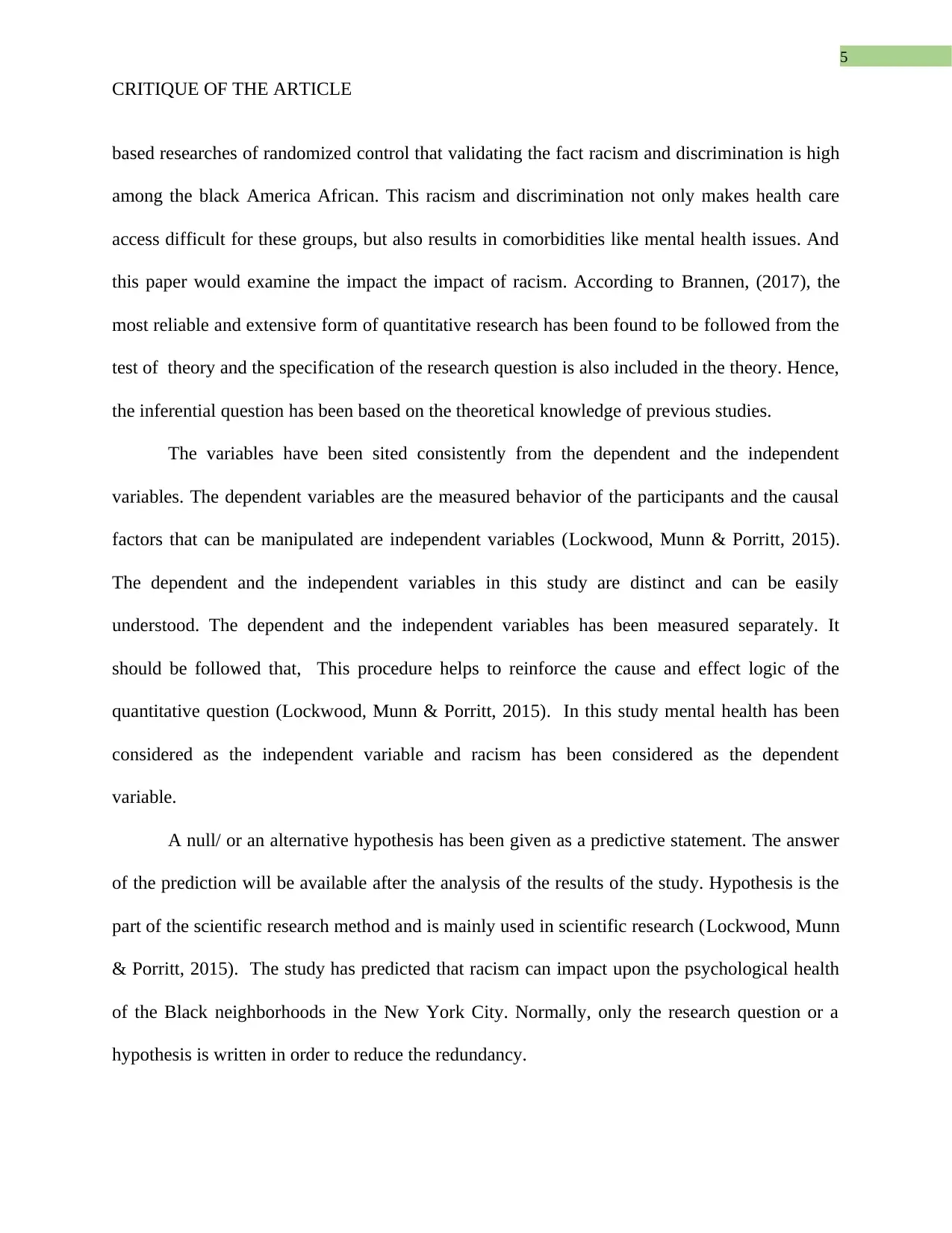
5
CRITIQUE OF THE ARTICLE
CRITIQUE OF THE ARTICLE
based researches of randomized control that validating the fact racism and discrimination is high
among the black America African. This racism and discrimination not only makes health care
access difficult for these groups, but also results in comorbidities like mental health issues. And
this paper would examine the impact the impact of racism. According to Brannen, (2017), the
most reliable and extensive form of quantitative research has been found to be followed from the
test of theory and the specification of the research question is also included in the theory. Hence,
the inferential question has been based on the theoretical knowledge of previous studies.
The variables have been sited consistently from the dependent and the independent
variables. The dependent variables are the measured behavior of the participants and the causal
factors that can be manipulated are independent variables (Lockwood, Munn & Porritt, 2015).
The dependent and the independent variables in this study are distinct and can be easily
understood. The dependent and the independent variables has been measured separately. It
should be followed that, This procedure helps to reinforce the cause and effect logic of the
quantitative question (Lockwood, Munn & Porritt, 2015). In this study mental health has been
considered as the independent variable and racism has been considered as the dependent
variable.
A null/ or an alternative hypothesis has been given as a predictive statement. The answer
of the prediction will be available after the analysis of the results of the study. Hypothesis is the
part of the scientific research method and is mainly used in scientific research (Lockwood, Munn
& Porritt, 2015). The study has predicted that racism can impact upon the psychological health
of the Black neighborhoods in the New York City. Normally, only the research question or a
hypothesis is written in order to reduce the redundancy.
CRITIQUE OF THE ARTICLE
CRITIQUE OF THE ARTICLE
based researches of randomized control that validating the fact racism and discrimination is high
among the black America African. This racism and discrimination not only makes health care
access difficult for these groups, but also results in comorbidities like mental health issues. And
this paper would examine the impact the impact of racism. According to Brannen, (2017), the
most reliable and extensive form of quantitative research has been found to be followed from the
test of theory and the specification of the research question is also included in the theory. Hence,
the inferential question has been based on the theoretical knowledge of previous studies.
The variables have been sited consistently from the dependent and the independent
variables. The dependent variables are the measured behavior of the participants and the causal
factors that can be manipulated are independent variables (Lockwood, Munn & Porritt, 2015).
The dependent and the independent variables in this study are distinct and can be easily
understood. The dependent and the independent variables has been measured separately. It
should be followed that, This procedure helps to reinforce the cause and effect logic of the
quantitative question (Lockwood, Munn & Porritt, 2015). In this study mental health has been
considered as the independent variable and racism has been considered as the dependent
variable.
A null/ or an alternative hypothesis has been given as a predictive statement. The answer
of the prediction will be available after the analysis of the results of the study. Hypothesis is the
part of the scientific research method and is mainly used in scientific research (Lockwood, Munn
& Porritt, 2015). The study has predicted that racism can impact upon the psychological health
of the Black neighborhoods in the New York City. Normally, only the research question or a
hypothesis is written in order to reduce the redundancy.
Paraphrase This Document
Need a fresh take? Get an instant paraphrase of this document with our AI Paraphraser
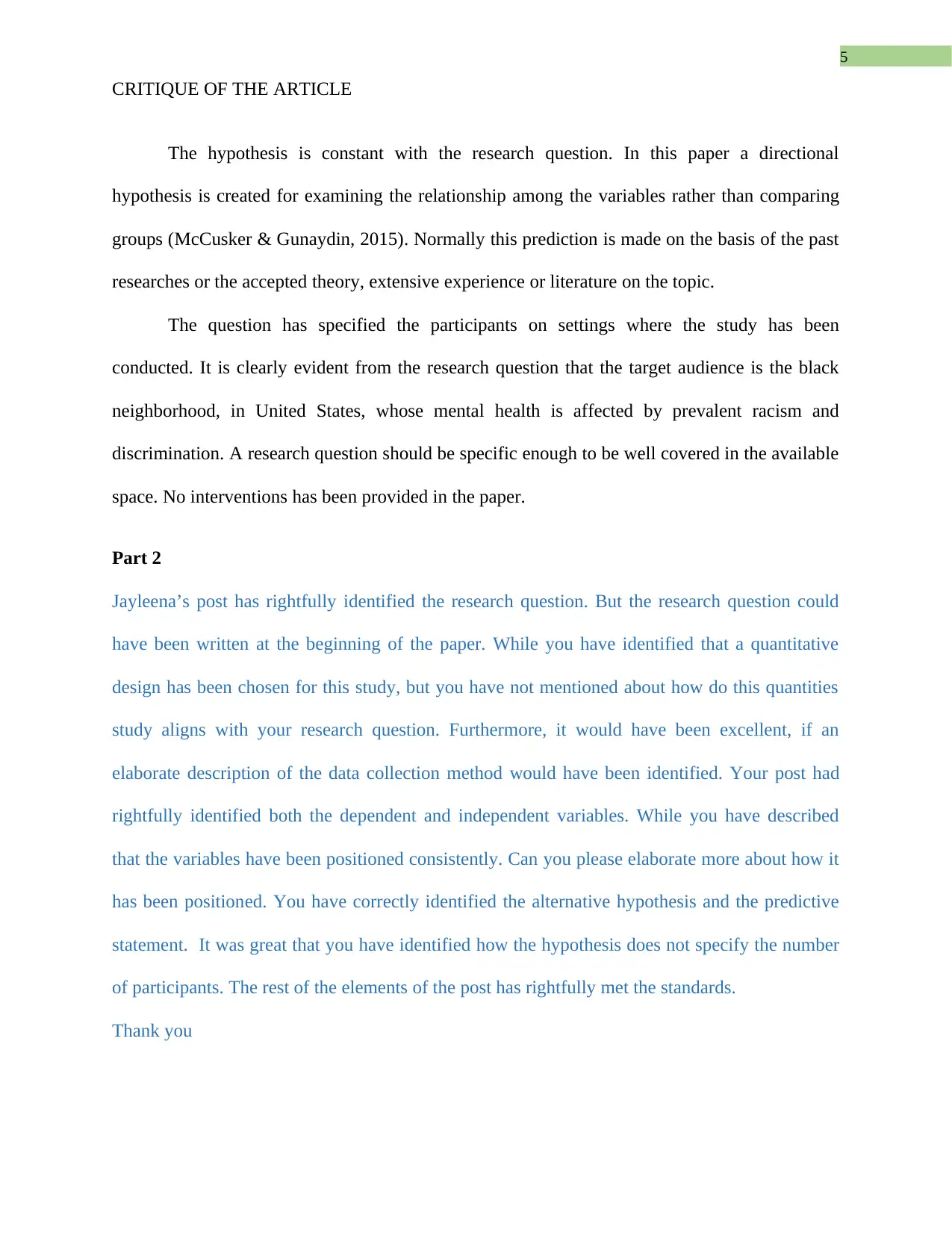
5
CRITIQUE OF THE ARTICLE
CRITIQUE OF THE ARTICLE
The hypothesis is constant with the research question. In this paper a directional
hypothesis is created for examining the relationship among the variables rather than comparing
groups (McCusker & Gunaydin, 2015). Normally this prediction is made on the basis of the past
researches or the accepted theory, extensive experience or literature on the topic.
The question has specified the participants on settings where the study has been
conducted. It is clearly evident from the research question that the target audience is the black
neighborhood, in United States, whose mental health is affected by prevalent racism and
discrimination. A research question should be specific enough to be well covered in the available
space. No interventions has been provided in the paper.
Part 2
Jayleena’s post has rightfully identified the research question. But the research question could
have been written at the beginning of the paper. While you have identified that a quantitative
design has been chosen for this study, but you have not mentioned about how do this quantities
study aligns with your research question. Furthermore, it would have been excellent, if an
elaborate description of the data collection method would have been identified. Your post had
rightfully identified both the dependent and independent variables. While you have described
that the variables have been positioned consistently. Can you please elaborate more about how it
has been positioned. You have correctly identified the alternative hypothesis and the predictive
statement. It was great that you have identified how the hypothesis does not specify the number
of participants. The rest of the elements of the post has rightfully met the standards.
Thank you
CRITIQUE OF THE ARTICLE
CRITIQUE OF THE ARTICLE
The hypothesis is constant with the research question. In this paper a directional
hypothesis is created for examining the relationship among the variables rather than comparing
groups (McCusker & Gunaydin, 2015). Normally this prediction is made on the basis of the past
researches or the accepted theory, extensive experience or literature on the topic.
The question has specified the participants on settings where the study has been
conducted. It is clearly evident from the research question that the target audience is the black
neighborhood, in United States, whose mental health is affected by prevalent racism and
discrimination. A research question should be specific enough to be well covered in the available
space. No interventions has been provided in the paper.
Part 2
Jayleena’s post has rightfully identified the research question. But the research question could
have been written at the beginning of the paper. While you have identified that a quantitative
design has been chosen for this study, but you have not mentioned about how do this quantities
study aligns with your research question. Furthermore, it would have been excellent, if an
elaborate description of the data collection method would have been identified. Your post had
rightfully identified both the dependent and independent variables. While you have described
that the variables have been positioned consistently. Can you please elaborate more about how it
has been positioned. You have correctly identified the alternative hypothesis and the predictive
statement. It was great that you have identified how the hypothesis does not specify the number
of participants. The rest of the elements of the post has rightfully met the standards.
Thank you

5
CRITIQUE OF THE ARTICLE
CRITIQUE OF THE ARTICLE
References
Brannen, J. (2017). Mixing methods: Qualitative and quantitative research. Routledge.
Kwate, N. O., & Goodman, M. S. (2015). Cross-sectional and longitudinal effects of racism on
mental health among residents of Black neighborhoods in New York City. American
Journal of Public Health, 105(4), 711–718. doi:10.2105/AJPH.2014.302243
Lockwood, C., Munn, Z., & Porritt, K. (2015). Qualitative research synthesis: methodological
guidance for systematic reviewers utilizing meta-aggregation. International journal of
evidence-based healthcare, 13(3), 179-187.
McCusker, K., & Gunaydin, S. (2015). Research using qualitative, quantitative or mixed
methods and choice based on the research. Perfusion, 30(7), 537-542.
Nardi, P. M. (2018). Doing survey research: A guide to quantitative methods. Routledge.
CRITIQUE OF THE ARTICLE
CRITIQUE OF THE ARTICLE
References
Brannen, J. (2017). Mixing methods: Qualitative and quantitative research. Routledge.
Kwate, N. O., & Goodman, M. S. (2015). Cross-sectional and longitudinal effects of racism on
mental health among residents of Black neighborhoods in New York City. American
Journal of Public Health, 105(4), 711–718. doi:10.2105/AJPH.2014.302243
Lockwood, C., Munn, Z., & Porritt, K. (2015). Qualitative research synthesis: methodological
guidance for systematic reviewers utilizing meta-aggregation. International journal of
evidence-based healthcare, 13(3), 179-187.
McCusker, K., & Gunaydin, S. (2015). Research using qualitative, quantitative or mixed
methods and choice based on the research. Perfusion, 30(7), 537-542.
Nardi, P. M. (2018). Doing survey research: A guide to quantitative methods. Routledge.
⊘ This is a preview!⊘
Do you want full access?
Subscribe today to unlock all pages.

Trusted by 1+ million students worldwide
1 out of 6
Related Documents
Your All-in-One AI-Powered Toolkit for Academic Success.
+13062052269
info@desklib.com
Available 24*7 on WhatsApp / Email
![[object Object]](/_next/static/media/star-bottom.7253800d.svg)
Unlock your academic potential
Copyright © 2020–2025 A2Z Services. All Rights Reserved. Developed and managed by ZUCOL.





